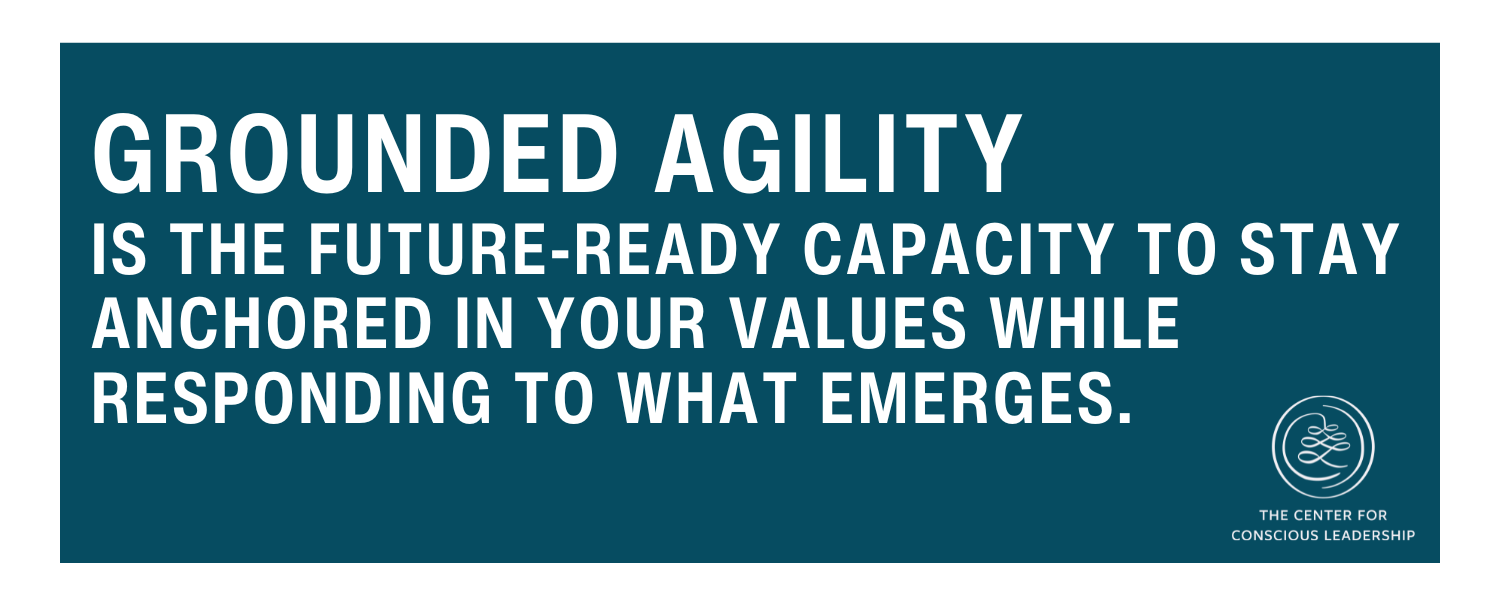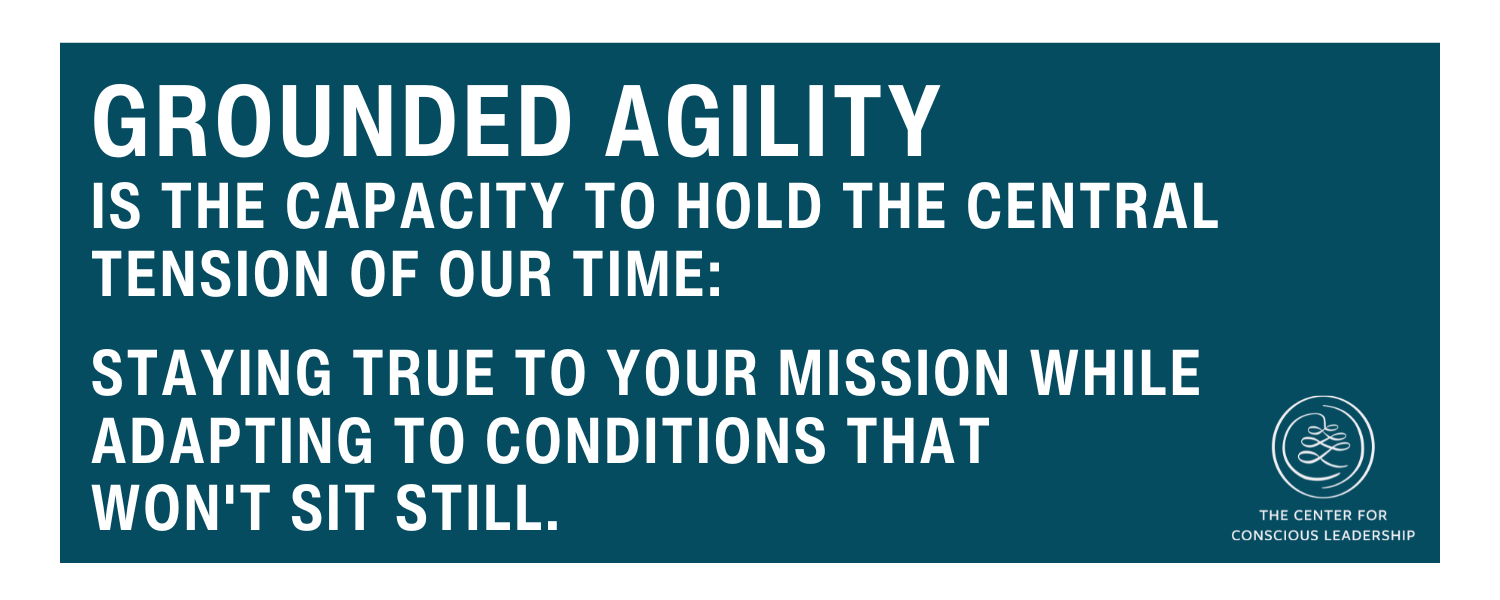Grounded Agility: The Paradox of Leading with Steadfast Flexibility
Leadership today demands an impossible balance: stay true to your values while adapting to conditions that shift daily.
Hold your ground without becoming rigid. Flex without losing your center. Move quickly without abandoning what matters most.
Most leaders collapse one side of this tension or the other.
Isaac clings to the mission. When a crucial player on his team needs unexpected time off, he panics. He refuses the request, saying they really need all hands on deck to meet their goal. He tightens his grip, prioritizing the plan over the person.
Keshia, in contrast, bends to every wind. When a client requests a deliverable two weeks ahead of schedule, she throws herself into the work, working through lunch and through the night at the expense of her health. She adapts immediately, abandoning herself and her values in her desire to be responsive and accommodating.
One sacrifices agility for the illusion of control. The other sacrifices grounding for the illusion of responsiveness. Both are protection strategies disguised as leadership.
Grounded Agility bridges this polarity. Grounded Agility is the capacity to stay rooted in your mission, vision, values, and humanity while adapting skillfully to whatever emerges. It's holding the tension between steadfastness and flexibility, and leading from the center of that tension.
The False Choice Between Speed and Stability
Modern leadership culture worships speed. We’re trying to reach our goals as fast as possible, often to the detriment of our own health and wellbeing. It’s no wonder why—leaders are under immense pressure to represent their teams as part of the larger organization as well as guide them to the finish line.
Hustle culture confuses constant movement with meaningful progress. When we measure someone's contribution by their Slack status and email response time, we miss what actually matters: the ingenuity of their ideas, the depth of their relationships, and the sustainability of their pace.
Both patterns are protection responses to uncertainty. One spins out in reactivity, the other locks down in resistance. Both cut leaders off from clarity, connection, and their core purpose.
These aren’t moral failings; they’re intelligent nervous system responses. When leaders feel unsafe–uncertain about outcomes, or threatened by loss of control–—their bodies choose protection over connection. Without awareness, these individual responses quietly become cultural norms—cultures that burn out fast movers and frustrate cautious ones.
So, what’s the alternative?
Grounded Agility–A Conscious Leader’s Secret Weapon
Grounded Agility isn't chasing every opportunity or clinging to the plan. It's knowing which adaptations serve your mission and which ones abandon it.
Grounded Agility recognizes the tension between conviction and flexibility, between staying true to who you are and responding to what's emerging. Leaders who successfully navigate this paradox don't get swept away by change, and they don't become irrelevant by resisting it. They hold both—and lead from that place of integrated strength.
Grounded Agility is leadership that honors both sides of the paradox: steady enough to stay true to your values, adaptive enough to respond to what the moment demands.
The Grounded Agility Model
There are four types of leadership illustrated in the model:
1. Reactive (Low Grounding, High Agility)
All speed, no compass.
The Pattern: These leaders prioritize urgency over intentionality. They pivot constantly, break things in the rush, and lose sight of what actually matters. Every problem feels like a five-alarm fire. In meetings, they interrupt, pivot mid-sentence, and leap to solutions before the problem is fully understood. Portrayed as strategic urgency—but at what cost?
The Impact: Their teams feel the whiplash. Decisions change daily, priorities shift hourly. The culture runs on adrenaline instead of trust, and people burn out chasing the next emergency.
The Cost: When everything is urgent, nothing is. When everything matters, nothing does. Urgency without discernment is chaos with a deadline.
2. Risk-Avoidant (High Grounding, Low Agility)
So cautious they calcify.
The Pattern: These leaders hide behind the appearance of principled leadership, but they're over-grounded to the point of rigidity. They default to legacy systems and familiar processes, even when conditions have changed. They delay decisions, seek excessive certainty, and resist innovation—not because they're protecting their values, but because adaptability feels like risking their credibility. Their nervous system equates stability with safety, and change with danger. You'll hear them say: "We need to be careful." "Let's not rush." "That's not how we do things."
The Impact: Their teams lose momentum. Opportunities pass while they wait for more data, more input, more certainty that will never come. The culture feels measured but stagnant. Trust erodes—not from recklessness, but from the exhaustion of watching leaders choose caution over courage.
The Cost: Over-grounded becomes immobilized. What looks like steadiness is actually fear—and fear doesn't lead, it stalls.
3. Autopilot (Low Grounding, Low Agility)
Neither steady nor adaptive.
The Pattern: These leaders are going through the motions—no clear values to anchor them, no responsiveness to what's actually happening. They show up, but they're not really present. They execute tasks without asking why. They're disengaged from the mission and disconnected from the moment.
The Impact: Meetings happen. Reports get filed. Nothing meaningful moves. Without direction or purpose, teams do what's expected but invest nothing extra. Energy flatlines.
The Cost: The culture becomes inert—people doing their jobs without purpose, energy, or growth.
4. Grounded Agility (High Grounding, High Agility)
Steady and adaptive—the integration of both.
The Pattern: These leaders are anchored in their mission, vision, and values, and they're flexible about how to achieve them based on what emerges. When a crisis hits, they don't freeze or spiral—they breathe, assess, and move with intention. They know when to pivot and when to hold steady. They adjust the plan without abandoning the purpose.
The Impact: Their teams trust them because their presence is consistent, even when circumstances change. The culture builds resilience instead of burning through people. This is leadership that holds the paradox: rooted enough to stay true, responsive enough to meet the moment.
The Cost: This is where sustainable performance lives. The result is trauma-informed decisions, lasting trust, and organizations that can navigate anything.
Grounded Agility is where calm meets courage. Grounded Agility is the future-ready capacity to stay anchored in your values while responding to what emerges, and is the integration sustainable leadership requires.
The question isn't whether you'll get pulled off center—you will.
The question is how quickly you can return.
Here's the practice.
Practicing Grounded Agility Using Mindfulness
Here’s how to put the framework to work:
1. Self-Scan
Ask: “Which quadrant am I operating from right now?”
Am I moving fast but losing my way (Reactive)? Grounded but stuck in caution (Risk-Avoidant)? Going through the motions without purpose or adaptation (Autopilot)? Or steady and adaptive (Grounded Agility)?
Scan your body: Does it feel like you're bracing against change? Racing to keep up? Checked out? Or centered and responsive?
2. Reflect
Ask: “What’s happening internally and externally? What am I responding to?”
What pressures are you facing—deadlines, resource constraints, competing priorities? What protection patterns are showing up? Are you rushing to avoid discomfort? Over-analyzing to avoid risk? Checking out to avoid overwhelm? What past experience is being echoed here that needs attention?
3. Recalibrate
Ask: “What does this moment call for? What would it look like to respond from deep grounding in my values and purpose?”
Maybe that means slowing down when urgency spikes—or speeding up when overthinking stalls your progress. Maybe it's pausing before you speak, breathing before you decide, or asking "What wants to emerge here?" before you create a solution. This is a great time to use the PBC Method.
The practice of Grounded Agility is returning to center, again and again, while staying responsive to what's actually happening. When we build this capacity, we integrate it into how we lead, the cultures we create, and the impact we sustain.
What Grounded Agility Looks Like in Practice
Let's return to Isaac and Keshia.
Isaac catches himself mid-panic. His chest is tight, his jaw clenched. He recognizes the pattern: He’s being Risk-Avoidant. He's about to refuse his team member's request—not because it's the right call, but because the change feels threatening to the mission.
He pauses, takes three slow breaths, and asks himself: "What does this moment call for? What matters most here?" Trust. Sustainability. Shared responsibility.
He tells his team member, "Yes, take the time you need. We’ll figure this out together." He convenes the team, names the gap honestly, and asks: "How can we redistribute this work in a way that doesn't burn anyone out?" They brainstorm, adjust, and the project stays on track. The team member returns feeling valued, and Isaac discovers that adapting didn't mean abandoning his values—it meant living them.
Keshia notices her body aching from lack of sleep. She recognizes her Reactive patterns. She's adapting to every demand without asking if it serves the mission.
She stops, grounds in her body, and asks herself: "What does this moment actually call for? What would it look like to respond from my values?" Collaboration. Sustainability. Excellence.
She calls a team meeting. "Before I react, I want to hear from you. What's actually feasible here?" Together, they realize the timeline is tight but doable with strategic adjustments. Keshia exhales. They move forward, aligned and grounded.
In both cases, the shift wasn't in strategy—it was in state. They paused, regulated, and let their values guide their response to what was happening and needs that were emerging.
The Leadership Imperative for Grounded Agility
Conscious leaders face fundamentally more complexity than leaders who optimize exclusively for results.
Leaders who commit to leading with humanity, must contend with the social, emotional, and relational variables that shape every decision. We can't ignore how people feel and expect sustainable performance. We can't push through change without considering its impact on trust.
Every decision ripples through your team's nervous systems. Regulation enables leaders to adapt to changing contexts and make the best decisions possible with what they know. Even the most brilliant strategies collapse under unfiltered stress.
Teams don’t need faster, harder-working, higher-octane leaders. They need grounded ones. Leaders who are steady, centered, and consistent, and model calm clarity instead of constant urgency and pressure. Grounded leaders who hold the paradox: staying true to their values and responsive to the moment.
Grounded leaders help their teams co-regulate, make choices that support long-term sustainability, and make hard calls without abandoning their integrity. This is the leadership the future demands—and the leadership people deserve.
An Invitation to Conscious Leaders
Grounded Agility is the capacity to hold the central tension of our time: staying true to your mission while adapting to conditions that won't sit still.
Grounded Agility is the bridge between conviction and flexibility, and between reflection and responsiveness.
It's how leaders stay human in the face of chaos without losing their way.
If you want to cultivate leaders who can hold this paradox—who stay calm in the storm, move with clarity, and create cultures that adapt without fracturing—book a discovery call or explore our Trauma-Informed Leadership Program.
Ready to build this capacity in your leaders? Let's talk.
The world we’re building requires leaders who are conscious, connected, and trauma-informed.
At The Center for Conscious Leadership, we help executives and organizations evolve—integrating neuroscience, trauma-informed leadership, and systems thinking to create cultures that heal and perform.
If you’re ready to build the future with us, explore our Trauma-Informed Leadership Program or connect to learn more about our coaching and systemic work.




